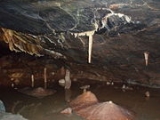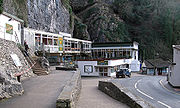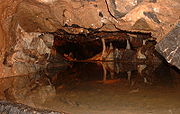
Gough's Cave
Encyclopedia
Gough's Cave is located in Cheddar Gorge on the Mendip Hills
, in Cheddar
, Somerset
, England. The cave is 90 metres (295 ft) deep and is 2.135 kilometres (1.33 mi) long,
and contains a variety of large chambers and rock formations. It contains the Cheddar Yeo
, the largest underground river system in Britain.
today. Electric lighting was installed in the show caves in 1899.
The cave is susceptible to flooding often lasting for up to 48 hours, however in the Great Flood of 1968
the flooding lasting for three days.
The extensive flooded parts of the cave system were found and explored between 1985 and 1990.
, were found a short distance inside Gough's Cave. He is Britain’s oldest complete human skeleton, having been dated to approximately 7150 BCE. There is a suggestion that the man died a violent death, perhaps related to cannibalism, although this has not been proven. Mitochondrial DNA
taken from the skeleton has been found to match that of Adrian Targett, a man living in the local area today, indicating that Cheddar Man is a very distant ancestor.
The remains currently reside in the Natural History Museum
in London, with a replica in the Cheddar Man and the Cannibals museum in the Gorge.
Other human remains have also been found in the cave.
In 2007 a carving of a mammoth
, estimated to be 13,000 years old, was found in the cave.
In 2010 further human bones from the cave were examined, which ultra-filtration carbon dating dated to around the end of the ice age 14,700 years ago. A second technique, using the Alicona 3D microscope, showed that the flesh had been removed from the bones using the same tools and techniques used on animal bones. According to Professor Chris Stringer
of the Natural History Museum
this supports theories about cannibalism amongst the people living or visiting the cave at that time. In February 2011, the same team published an analysis of human skull
s of the same date found at the cave around 1987, which they believe were deliberately fashioned into ritual drinking skull cups or bowls
.
 The first 820 metres (2,690 ft) of the cave are open to the public as a show cave, and this stretch contains most of the more spectacular formations. The greater part of the cave's length is made up of the river passage, which is accessible only by cave diving
The first 820 metres (2,690 ft) of the cave are open to the public as a show cave, and this stretch contains most of the more spectacular formations. The greater part of the cave's length is made up of the river passage, which is accessible only by cave diving
.
 Gough's cave contains long stretches of completely flooded river passage. From a point relatively close to the areas of the cave open to the public, the cave-divers'
Gough's cave contains long stretches of completely flooded river passage. From a point relatively close to the areas of the cave open to the public, the cave-divers'
descent into Sump
1a begins through a tight passage known as Dire Straits. The bottom of that passage opens into the river passage, which is several meters across. This has been explored for 335 m (1,099.1 ft) downstream, whilst upstream a dive of 150 m (492.1 ft) brings the diver out in a 20 m (65.6 ft) long chamber named Lloyd Hall (which can now also be reached by an alternative, dry, route).
Another dive of 140 m (459.3 ft) through Sump 1b, finishing with an ascent through a rising passage, leads to another chamber, 60 metres (197 ft) long and 25 metres (82 ft) wide at its widest point, and full of large boulders, called Bishop's Palace. This chamber is the largest chamber currently found in the Cheddar caves. Further on, three sump pools (named the Duck Ponds) lead to Sump 2 which is about 27 metres (89 ft) deep at its lowest point and 150 metres (492 ft) long.
Air is again reached at Sheppard's Crook, which is followed by Sump 3. This sump is 55 metres (180 ft) deep and at its bottommost point is about 30 metres (98 ft) below sea level. Following Sump 3, a wide ascending passage continues for 370 metres (1,214 ft) before reaching an impassable blockage, still below the water's surface.
Mendip Hills
The Mendip Hills is a range of limestone hills to the south of Bristol and Bath in Somerset, England. Running east to west between Weston-super-Mare and Frome, the hills overlook the Somerset Levels to the south and the Avon Valley to the north...
, in Cheddar
Cheddar
Cheddar is a large village and civil parish in the Sedgemoor district of the English county of Somerset. It is situated on the southern edge of the Mendip Hills, north-west of Wells. The civil parish includes the hamlets of Nyland and Bradley Cross...
, Somerset
Somerset
The ceremonial and non-metropolitan county of Somerset in South West England borders Bristol and Gloucestershire to the north, Wiltshire to the east, Dorset to the south-east, and Devon to the south-west. It is partly bounded to the north and west by the Bristol Channel and the estuary of the...
, England. The cave is 90 metres (295 ft) deep and is 2.135 kilometres (1.33 mi) long,
and contains a variety of large chambers and rock formations. It contains the Cheddar Yeo
Cheddar Yeo
The Cheddar Yeo is a small river in North Somerset, England. Beneath the limestone of the Mendip Hills it forms the largest underground river system in Britain. After emerging into Cheddar Gorge it flows through the village of Cheddar, where it has been used in the past to power mills...
, the largest underground river system in Britain.
History
The initial sections of the cave, previously known as Sand Hole, were accessible prior to the 19th century. Between 1892 and 1898 Richard Cox Gough, who lived in Lion House in Cheddar, found, excavated and opened to the public further areas of the cave, up to Diamond Chamber, which is the end of the show caveShow cave
Show caves — also called tourist caves, public caves, and in the United States, commercial caves — are caves that are managed by a government or commercial organization and made accessible to the general public, usually for an entrance fee...
today. Electric lighting was installed in the show caves in 1899.
The cave is susceptible to flooding often lasting for up to 48 hours, however in the Great Flood of 1968
Great Flood of 1968
The Great Flood of 1968 was a flood caused by very heavy rain that struck South East England and France in mid-September 1968, with the worst on Sunday 15 September 1968, and followed earlier floods in South West England during July.-South West England:...
the flooding lasting for three days.
The extensive flooded parts of the cave system were found and explored between 1985 and 1990.
Human remains and occupation
In 1903 the remains of a human male, since named Cheddar ManCheddar Man
Cheddar Man is the name given to the remains of a human male found in Gough's Cave in Cheddar Gorge, Somerset, England. The remains date to approximately 7150 BC, and it appears that he died a violent death. It is Britain’s oldest complete human skeleton....
, were found a short distance inside Gough's Cave. He is Britain’s oldest complete human skeleton, having been dated to approximately 7150 BCE. There is a suggestion that the man died a violent death, perhaps related to cannibalism, although this has not been proven. Mitochondrial DNA
Mitochondrial DNA
Mitochondrial DNA is the DNA located in organelles called mitochondria, structures within eukaryotic cells that convert the chemical energy from food into a form that cells can use, adenosine triphosphate...
taken from the skeleton has been found to match that of Adrian Targett, a man living in the local area today, indicating that Cheddar Man is a very distant ancestor.
The remains currently reside in the Natural History Museum
Natural History Museum
The Natural History Museum is one of three large museums on Exhibition Road, South Kensington, London, England . Its main frontage is on Cromwell Road...
in London, with a replica in the Cheddar Man and the Cannibals museum in the Gorge.
Other human remains have also been found in the cave.
In 2007 a carving of a mammoth
Mammoth
A mammoth is any species of the extinct genus Mammuthus. These proboscideans are members of Elephantidae, the family of elephants and mammoths, and close relatives of modern elephants. They were often equipped with long curved tusks and, in northern species, a covering of long hair...
, estimated to be 13,000 years old, was found in the cave.
In 2010 further human bones from the cave were examined, which ultra-filtration carbon dating dated to around the end of the ice age 14,700 years ago. A second technique, using the Alicona 3D microscope, showed that the flesh had been removed from the bones using the same tools and techniques used on animal bones. According to Professor Chris Stringer
Chris Stringer
Christopher Brian Stringer FRS, better known as Chris Stringer, is a British anthropologist.He is one of the leading proponents of the recent single-origin hypothesis or "Out of Africa" theory, which hypothesizes that modern humans originated in Africa over 100,000 years ago and replaced the...
of the Natural History Museum
Natural History Museum
The Natural History Museum is one of three large museums on Exhibition Road, South Kensington, London, England . Its main frontage is on Cromwell Road...
this supports theories about cannibalism amongst the people living or visiting the cave at that time. In February 2011, the same team published an analysis of human skull
Human skull
The human skull is a bony structure, skeleton, that is in the human head and which supports the structures of the face and forms a cavity for the brain.In humans, the adult skull is normally made up of 22 bones...
s of the same date found at the cave around 1987, which they believe were deliberately fashioned into ritual drinking skull cups or bowls
Skull cup
A skull cup is a drinking vessel or eating bowl made from an inverted human calvaria that has been cut away from the rest of the skull. The use of a human skull as a drinking cup in ritual use or as a trophy is reported in numerous sources throughout history and among various peoples, and among...
.
Access and Description

Cave diving
Cave diving is a type of technical diving in which specialized equipment is used to enable the exploration of caves which are at least partially filled with water. In the United Kingdom it is an extension of the more common sport of caving, and in the United States an extension of the more common...
.
Beyond the show cave

Cave diving
Cave diving is a type of technical diving in which specialized equipment is used to enable the exploration of caves which are at least partially filled with water. In the United Kingdom it is an extension of the more common sport of caving, and in the United States an extension of the more common...
descent into Sump
Sump (cave)
Sump is a term used in caving to describe a submerged passage in a cave. A sump may be static, with no inward or outward flow, or active, with continuous through-flow...
1a begins through a tight passage known as Dire Straits. The bottom of that passage opens into the river passage, which is several meters across. This has been explored for 335 m (1,099.1 ft) downstream, whilst upstream a dive of 150 m (492.1 ft) brings the diver out in a 20 m (65.6 ft) long chamber named Lloyd Hall (which can now also be reached by an alternative, dry, route).
Another dive of 140 m (459.3 ft) through Sump 1b, finishing with an ascent through a rising passage, leads to another chamber, 60 metres (197 ft) long and 25 metres (82 ft) wide at its widest point, and full of large boulders, called Bishop's Palace. This chamber is the largest chamber currently found in the Cheddar caves. Further on, three sump pools (named the Duck Ponds) lead to Sump 2 which is about 27 metres (89 ft) deep at its lowest point and 150 metres (492 ft) long.
Air is again reached at Sheppard's Crook, which is followed by Sump 3. This sump is 55 metres (180 ft) deep and at its bottommost point is about 30 metres (98 ft) below sea level. Following Sump 3, a wide ascending passage continues for 370 metres (1,214 ft) before reaching an impassable blockage, still below the water's surface.
| Sump | Length of dive | Depth | Emerging into |
|---|---|---|---|
| Sump 1a | 150 metres (492 ft) | 18 metres (59 ft) | Lloyd Hall |
| Sump 1b | 140 metres (459 ft) | ? | Bishop's Palace |
| Sump 2 | 150 metres (492 ft) with airbells | 27 metres (89 ft) | Sheppard's Crook |
| Sump 3 | 370 metres (1,214 ft) | 55 metres (180 ft) | Passage blocked |

